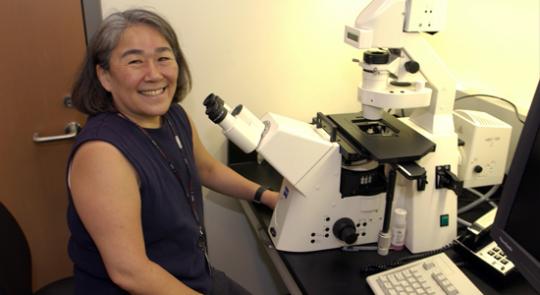
A team of investigators has developed an innovative blood test that may provide a faster, simpler way for emergency room doctors and others to diagnose and monitor potentially deadly aortic aneurysms and aortic dissections (a tear in the wall of the aorta) for which early diagnosis is critical for survival. The aorta is the large artery that carries blood away from the heart. Aortic aneurysms and dissections, which often have symptoms similar to a heart attack, cause more than 10,000 deaths annually in the U.S., according to the Centers for Disease Control. Certain types of dissections (Type A), if left untreated, kill 33% of patients within the first 24 hours, and 50% of patients within 48 hours, according to research by the International Registry of Acute Aortic Dissections (IRAD).
The research from Shriners Hospital for Children and Oregon Health & Science University, Portland, and Baylor College of Medicine and the Texas Heart Institute in Houston, which was published online today by Circulation Research, found that high blood levels of fibrillin-1, a protein essential to the make-up of the body’s connective tissue and blood vessels, are about twice as common in people with thoracic aortic aneurysm than in people with other types of aortic aneurysms. The high fibrillin-1 levels most likely are caused by damage to connective tissue or blood vessels. The researchers also found that high levels of fibrillin-1 fragments are more likely to be associated with aortic dissection, the life-threatening tear in the aorta. These new findings are potentially revolutionary because they mean that fibrillin-1 could someday be used in a blood test to diagnose aortic aneurysm and dissection. Currently the diagnosis is made through medical imaging, such as echocardiography, MRI, and CT scanning.
According to Dr. Lynn Sakai, a biochemist and researcher from Shriners Hospital for Children, the original goal of this study was to provide better management of aortic disease for children and adults with Marfan syndrome, a life-threatening genetic disorder that puts people at up to 250 times increased risk of aortic dissection as compared to the general public. Dr. Sakai, whose research group first cloned the gene for fibrillin-1 (the Marfan gene), initiated the current research with funding from The Marfan Foundation and Shriners Hospitals for Children. Additional funding was secured from the National Heart, Lung, and Blood Institute.
“These findings are significant for public health because they represent the first human data to show that fibrillin-1 in blood could be a biomarker for thoracic aortic aneurysm and dissection,” said Dr. Lynn Marshall, an epidemiologist from Oregon Health& Science University and the lead author of the study.
In the future, promising biomarker tests may be used in the hospital emergency department to facilitate the diagnosis of aortic dissection or in the doctor’s office during a routine physical exam to uncover signs of developing aneurysmal disease. These tests could benefit patients with Marfan syndrome, as well as those with Loeys-Dietz syndrome, vascular Ehlers Danlos syndrome, and familial thoracic aortic aneurysm and dissection.
“This is an excellent example of how research aimed at a rare genetic disorder helps people with similar diseases that are common in the general population,” said Dr. Susan Hayflick, Chair of Molecular and Medical Genetics, Oregon Health & Science University. “It is also an excellent example of how a multidisciplinary team of investigators can pool their expertise and resources for translational research that can directly enhance patient care.”
Patients have the best outcomes when they know they are at risk for aortic enlargement. Then, they can have their aorta monitored and plan surgery to repair the aorta before a life-threatening dissection or rupture. Surgery is usually recommended based on the rate of enlargement of the aorta and the actual diameter. Survival rates after planned surgery to repair the aorta are very good (greater than 95%) in centers with the expertise. However, the results are less positive in the emergency department. A person with unexplained chest, back, or abdominal pain who does not know they are at increased risk of aortic dissection may not be treated with the same urgency as those who know their risk. In addition, doctors may consider other diagnoses first, delaying the urgent life-saving care needed to treat someone with an aortic dissection. If the diagnosis of aortic tear or rupture is made quickly, surgery can be successful based on IRAD data, early survival is about 75% for surgical treatment of acute ascending dissection. Without treatment, the risk of death increases 1% each hour in the first 48 hours.
“Biomarkers for aortic aneurysm and dissection are necessary because the presence of these conditions in the chest cannot be detected without appropriate imaging,” said Dr. Scott LeMaire, Professor and Vice Chair for Research in the Michael E. DeBakey Department of Surgery, Baylor College of Medicine. “A chest x-ray cannot reliably detect an aortic tear or aneurysm and, too frequently, by the time doctors dismiss the more common causes of chest pain, it is too late to help the patient.”
The Next Step
“Our next step is to measure fibrillin-1 levels over several years in patients at high risk for aortic aneurysms. Long-term studies with large numbers of patients are the best way to determine whether the blood test is sensitive enough to monitor aortic aneurysm development or detect dissection,” said Dr. Marshall.
This work is already under way by the research team. A 5-year study of children and young adults is currently open for enrollment at the Portland and Houston Shriners Hospitals for Children and at the University of Utah. The study will monitor both circulating fibrillin-1 and echocardiograms of aortic root size in patients with Marfan syndrome and related disorders (Loeys-Dietz syndrome, familial thoracic aortic aneurysm and dissection, and vascular Ehlers-Danlos syndrome) to determine if the amounts of fibrillin-1 in blood increase with aneurysm growth.

The Marfan Foundation is a nonprofit organization that saves lives and improves the quality of life of individuals with genetic aortic and vascular conditions including Marfan, Loeys-Dietz, and Vascular Ehlers-Danlos syndromes. Our vision is a world in which everyone with genetic aortic and vascular conditions can live their best life.
